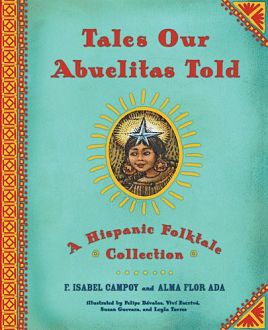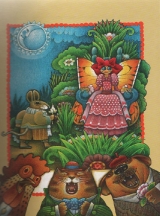Tales Our Abuelitas Told
Cuentos que contaban nuestras abuelas
RECOGNITIONS
Literary Guild Medal
Kirkus Best Books, Kirkus Review
A Parent’s Choice Recommended Book
Best Books of the Year, Books for a Global Society SIG – American Library Association
Best Folklore in Best Books of the Year, Nick Jr. Magazine
Featured Book of the Month, Colorín Colorado Website, American Federation of Teachers
List of Best Books for 2006, New York Public Library
BOOK DESCRIPTION
Twelve stories from varied roots of Hispanic culture come together in a colorful collection that includes talking ants, magic bagpipes, dancing goats, and flying horses. In some cases the tales emphasize a moral, such as looking for the good in any bad situation as in “Catlina the Fox.” In others, the story illustrates the importance of friends, as in the case of “The Bird of One Thousand Colors.”
The authors seek to trace the origins of the stories through personal source notes, citing variants of the original story and the historical themes behind the tales. Of note is a tale of Juan Bobo that is included in this collection. Juan Bobo has entertained children and adults for more than five centuries with his antics and absent-mindedness. While Juan Bobo is well known by many, “The Bird of One Thousand Colors” is a story that Alma Flor Ada was unable to trace to an original source, although she remembers being told the story by her grandmother.
Throughout the collection, culturally accurate illustrations catch the eye with vivid colors and intricate details that convey aspect of the story. Each story leads naturally to the next, keeping alive the oral traditions of a rich culture that spans the continents
AUTHORS’ NOTE
Writing Tales Our Abuelitas Told was for me a way of honoring my extraordinary grandmother, Dolores Salvador, as well as and an expression of love and hope for my nine grandchildren, as I have expressed in my dedication. I am sure it means something very similar for Isabel, whose dedication is to her great-nephew Pablito. We are very grateful that these beloved tales are being so well received assuring that their continue to live for all children.
Traditional tales open our hearts to old voices and new worlds, to wondrous adventures and ever lasting feelings. Words like Había una vez or Érase que se era, hold for the listener or reader the magic promise of enchantment.
The stories retold Tales Our Abuelitas Told or, in the Spanish version Cuentos que contaban nuestras abuelas, reflect the diversity of our culture: some developed in Latin America from Indigenous roots, others had their origin in Africa or in various regions of Spain and go back to the Hebrew, Arabic or Basque traditions.
Their settings may be Mexico or the Southwest, Puerto Rico, Cuba or the Amazon among many others. They all keep children spell-bound. Stories like these enriched our childhood and left our imagination forever open to new discoveries, to the daring possibility of dreaming better worlds. Words like ¨happily ever after¨ got transformed into lives in search of understanding and compassion, lives devoted to promote access and equality for all, social justice, and peace.
Image Gallery
BOOK REVIEWS
School Library Journal
Grade 3 & Up: The introduction to this delightful collection explains clearly how stories develop and change over time; in fact, the two storytellers heard most of these amusing tales when they were children and have retold them many times since in their own unique styles. Each retelling is accompanied by a brief description of its origin. Included are tales about dancing goats, a turtle that outwits a deer, and a beetle that declares war on a cow; all of the selections are peppered with energetic dialogue and witty detail. Children will relish their humor, especially if read aloud, and teens will also enjoy this lively presentation. Traditional story beginnings and endings are provided in Spanish and translated into English, including one foreboding opening: In a land where you will go but from where you will never return. Four Latino artists provide an interesting variety of illustration. Featured images include a large goat head in a vegetable garden, a large farmer on a very small burro, and a wolf and fox all decked out in finery dancing together. The last page provides information about the authors and illustrators. Many libraries may already have Lucia M. Gonzalez’s Señor Cats Romance (Scholastic, 2001), but only one tale is common to both collections. Make room on your shelves for this excellent book.
Booklist
The long chatty notes are as interesting as the 12 folktales in this anthology of stories retold by Ada and Campoy and illustrated by well-known Latino artists. The authors celebrate Hispanic culture and its many roots–indigenous, African, Spanish, Arab, Hebrew–assembling tales from as far afield as Spain and Idaho, and showing how the tales have transformed and influenced one another, and even how Ada and Campoy have changed them. The folklore universals are here: the kid who defeats his mean older brothers; the huge monster routed by an ant; and more. In “Blancaflor,” the evil king’s daughter and the young prince fulfill three tasks together and prove the power of love. The spacious book design will work well for both independent reading and reading aloud, and each story is illustrated with one or more full-page pictures in styles that match the stories–from busy and filled to bursting to light and airy.
Children’s Literature: A six-page introduction welcomes readers and offers historical background into the ways that folktales originated and intermingled in all cultures. The twelve Hispanic tales actually have roots in many ancient traditions. The conversational tone continues into the retelling of the selected tales ranging in length from three to seventeen pages (including at least one full-page illustration for each). A few of the tales will seem somewhat familiar. “Dear Deer! Said the Turtle” is reminiscent of “The Tortoise and the Hare.” “The Castle of Chuchurumbe” has a rhythm similar to “The House That Jack Built.” Catalina the Fox could be related to Brer Rabbit. Other tales bring fresh, new perspectives. Pedro saves his family’s corn and, eventually, finds great happiness because he befriends a little horse of seven colors and follows its advice. A caliph and his son discover the source of true happiness in unexpected places. Research and explanatory notes follow each tale. Colorful illustrations capture the mood of the narrative, often contributing to understanding of the text and adding humor. The artists are given individual recognition in the table of contents. A listing of traditional folk tale beginnings is provided in both Spanish and English in the front of the book. A similar listing of endings appears in the back. The large-style format lends itself well to both individual reading and group sharing.
Reseñas/Book Reviews Berkeley Public Library
An illustrated collection of lively stories – reflecting elements of Spanish, Arabic, Celtic, African, Jewish, and Mexican roots – retold by the dynamic Ada and Campoy duo. The cuentos include several from Cuba, others from various regions of Spain such as Galicia and Andalusia. Also reflected is Spain’s diverse population: farmers in the North and Califs that once ruled the South of Spain. The selections hold universal appeal, employing themes common to many folklore collections. Accompanying the entries are captivating illustrations from four outstanding artists, each using his/her unique artistic style to capture the reader’s attention. The authors’ historical knowledge of the stories is evident in the notes that introduce this volume. With a few minor problems relating to the origination of the stories, this is a wonderful book.
COMMENDATIONS
Simon Brooks:
I have gone into the studio to begin recording what is most likely to be called “More Second-hand Tales.” I know, amazingly original, isn’t it? For those who saw me over this summer, you might remember me telling the story ‘The Goat from the Hills and Mountains.” This tale was new to me this year and I have fallen in love with it. It is based on an Hispanic tale I found in a marvelous book called TALES OUR ABUELITAS TOLD by F. Isabel Campoy and Alma Flor Ada, published by Atheneum. I could not find an original source for the story, or any other version of it, so I approached the authors for permission to continue telling the tale and also for permission to record it, on this soon-to-be-made second CD. After a few emails with both writers I have permission to continue to tell the story AND record my version of Alma Flor Ada’s version of this story which appears in the book. The book is wonderful, and there are many other great stories in there. If you are looking for a holiday gift to give someone this coming winter season, be it Christmas, Chanukah, Quanza, or any other holiday, or birthday even, then look this book over. It is not a ‘dry’ folklore book, but a book filled with the life and vitality which makes Hispanic stories so wonderful. It is also illustrated in a style that captures the tales in a unique way that kids love. I know this as we have a copy of it at my library. Many thanks to Isabel and Alma for graciously allowing me to take this tale and put it on my second CD.
BLOGS
Tales Our Abuelitas Told is a lovely collection of Hispanic folktales from many different cultures, written/retold by F. Isabel Campoy and Alma Flor Ada. Abuelitas is an endearment in Spanish for “grandmothers,” and these tales, full of life lessons, are told with the loving care of our grandmothers.
These stories have journeyed far — over mountains, deserts, and oceans — carried by wind, passed on to us by our ancestors. Now they have found their way to you.
A sly fox, a bird of a thousand colors, a magical set of bagpipes, and an audacious young girl … A mixture of popular tales and literary lore, this anthology celebrates Hispanic culture and its many roots — Indigenous, African, Hebrew, and Spanish.
In the introduction to the book, the authors explain the history of Hispanic folklore, which I found fascinating. Twelve tales are retold and beautifully illustrated, each one ending with a brief explanation of the different versions of the story and the authors’ connections to it. My favorite was “The Happy Man’s Tunic,” a story brought to Spain most likely by the Arabs. In the story, a caliph was too busy to spend time with his kind and loving son. When his son became ill, the caliph consulted many physicians. But when none of them could find the right cure, and he despaired, an old woman came to him and told him that all his son needed to get well was to wear the tunic of a man who is truly happy. The search was on, and a young shepherd was finally found who proved to be a truly happy man. The problem was…he didn’t own a tunic! It’s a fun story with an important message, but I won’t give it away here.
The authors also included a fun list of traditional beginnings and endings to stories told in Spanish, side by side with their English-language equivalents:
Había una vez…
En los tiempos e la abuela…
Hace mucho tiempo…
…y colorín colorado, este cuento se ha acabado.
Once upon a time…
In Grandmother’s time…
A long time ago…
…and, my many-colored feathered friend, now the story has found an end.
It’s exciting to find a book of folktales that is done so nicely. This is a lovely book, beautifully written and illustrated, and it would be a great addition to a family’s collection of folktales, and a wonderful book to use as a teaching tool in school for any age group. –Christine
READERS’ RESPONSES
If you have enjoyed reading or sharing this book, I would very much like to hear from you. Please click here to send your comments.




